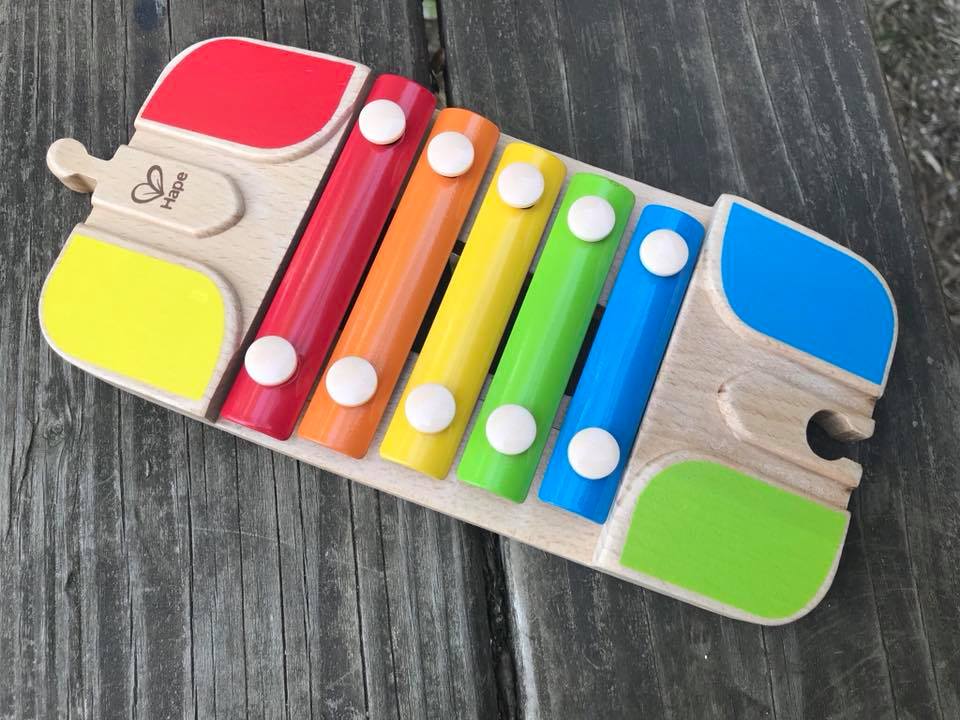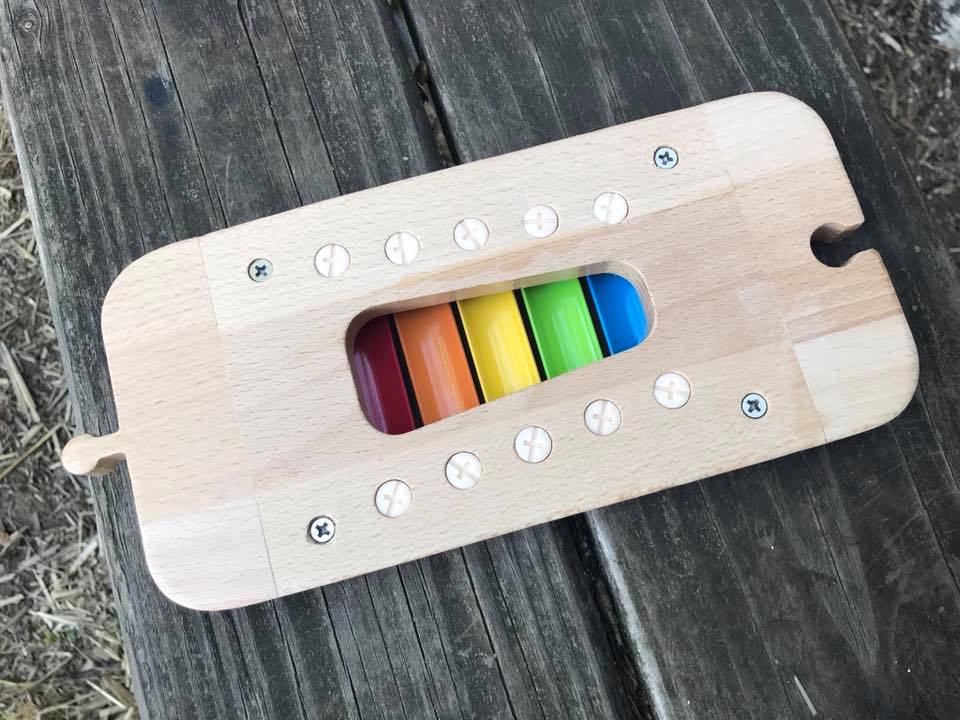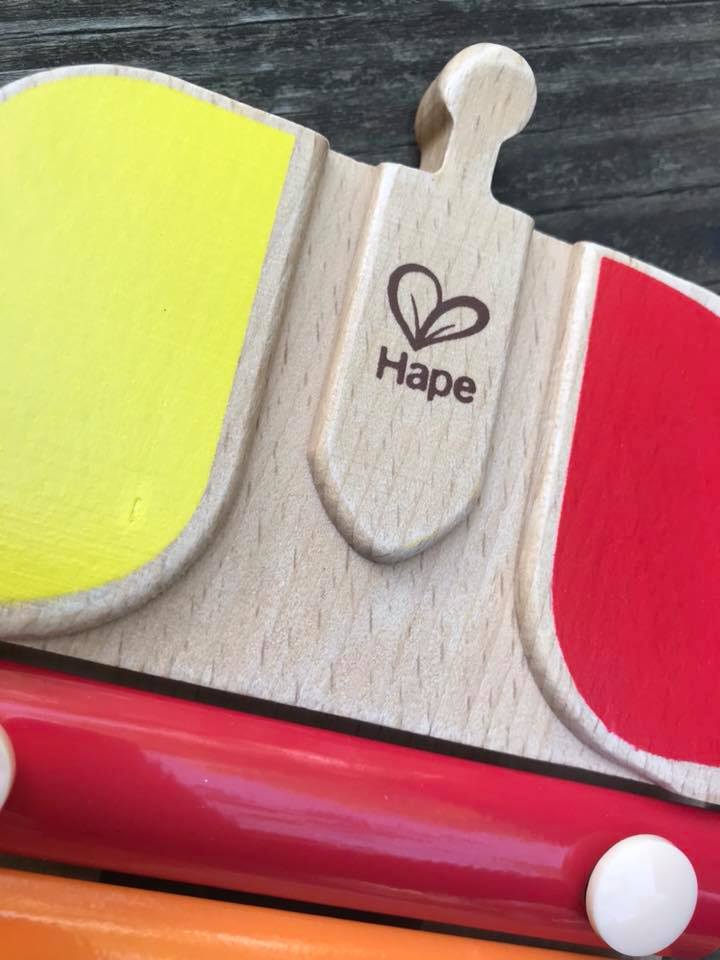Hape Wooden Railway Kid’s Xylophone Melody Track
When I coordinate XRF testing of consumer goods for my friends and followers I ask them to send me a box with one complex item and up to nine simple items. I usually test these ten personal items for people in thanks for their $150 contribution that helps to cover the costs of the XRF testing (which can be more than $700 a day!) and other costs related to my advocacy.
This testing then generates the results we report here on the website so that readers can know what things are made of (and can use this information to make safer choices for their families.) I am always incredibly thankful for those who support my advocacy in this way.
To see more items I have tested, click here.
These supporters of my work are truly playing an active role in this independent consumer goods testing, testing that otherwise would not be possible. Without their contributions and items sent in, we would not have found lead in fidget spinners or lead in baby bottles or lead in so many other things we have found together over the past two years!
To learn more about XRF testing, click here.
The toy picture here (the Xylophone Train Track from Hape) is a really good example of a “complex” item.
In order to comprehensively test this item each of the components (listed below) needed to be tested multiple times (to confirm the levels) and while this looks like just “one” thing (a toy) it really has twelve separate “components” that need to be tested.
To see this exact toy on Amazon*, click here.
In this particular case, these test results should also truly be considered a “screening” and not 100% exact (they are however, as exact as possible within the noted margin of error) because with this testing (and all the testing I do) the components have been tested with the item assembled (since the item does not belong to me, and I did not have permission to disassemble [and/or destroy!] the item for more through testing.) If the item were taken apart for testing it is possible that some of the XRF test results would vary slightly.
For example the testing of the metal screws included some of the wood in the surrounding toy as the metal screws are smaller than the scope of the instrument and set into the wood. In this example the metals reading in parts per million for the screw are “diluted” by the wood that is also in the test sample.
It is important to note that testing a toy that is already assembled does not negate the test results for elements like lead, cadmium, arsenic and mercury. IF any element is there it would be detected by the XRF to a fairly accurate level, however if the component tested is smaller than the scope (reading window) of the XRF instrument the levels would be slightly lower than if the component was tested on its own (not in-situ on the toy.)
To see more toys I have tested, click here.
Here are the XRF test results for each of these twelve components.
1. Plastic “Screws”:
- Titanium (Ti): 1,241 +/- 343 ppm
2. Metal Screws:
- Chromium (Cr): 9,345 +/- 183 ppm
- Copper (Cu): 677 +/- 49 ppm
- Nickel (Ni): 313 +/- 34 ppm
- Iron (Fe): 39,900 +/- 600 ppm
- Vanadium (V): 204 +/- 108 ppm
3. Bare Wood:
- ND for all
4. Green Paint on Wood:
- Titanium (Ti): 1,520 +/ 362 ppm
5. Green Paint on Metal:
- Tin (Sn): 190 +/- 81 ppm
- Zinc (Zn): 509 +/- 174 ppm
- Copper (Cu): 653 +/- 289 ppm
- Iron (Fe): 900,600 +/- 64,000 ppm
- Titanium (Ti): 36,200 +/-3,000 ppm
- Cobalt (Co): 11,600 +/- 1,700 ppm
- Manganese (Mn): 1,437 +/- 512 ppm
6. Blue Paint on Wood:
- Zinc (Zn): 18 +/- 7 ppm
- Copper (Cu): 53 +/- 10 ppm
- Titanium (Ti): 5,307 +/- 328 ppm
7. Blue Paint on Metal:
- Copper (Cu): 4,878 +/- 692 ppm
- Iron (Fe): 802,700 +/- 52,000 ppm
- Titanium (Ti): 54,400 +/- 9,300 ppm
- Cobalt (Co): 14,500 +/- 1,800 pm
- Manganese (Mn): 1,336 +/- 495 ppm
8. Red Paint on Wood:
- Titanium (Ti): 603 +/- 296 ppm
- Zinc (Zn): 14 +/- 8 ppm
9. Red Paint on Metal:
- Iron (Fe): 757,800 +/- 49,000 ppm
- Titanium (Ti): 22,300 +/- 1,600 ppm
- Cobalt (Co): 11,700 +/- 1,700 ppm
- Manganese (Mn): 944 +/- 471 ppm
10. Yellow Paint on Wood:
- Barium (Ba): 220 +/- 123 ppm
- Zinc (Zn): 28 +/- 9 ppm
- Titanium (Ti): 4,890 +/- 384 ppm
11. Yellow Paint on Metal:
- Zinc (Zn): 291 +/- 105 ppm
- Copper (Cu): 393 +/- 184 ppm
- Iron (Fe): 521,600 +/- 28,00 ppm
- Titanium (Ti): 99,900 +/- 2,600 ppm
- Cobalt (Co): 15,100 +/- 1,500 ppm
- Manganese (Mn): 940 +/- 455 ppm
12. Orange Paint on Metal:
- Chromium (Cr): 410 +/- 103 ppm
- Iron (Fe): 782,400 +/- 47,000 ppm
- Titanium (Ti): 44,100 +/- 2,600 ppm
- Cobalt (Co): 12,400 +/- 1,500 ppm
- Manganese (Mn): 1,222 +/- 455 ppm
As always, please let me know if you have any questions!
Thank you so much for reading and for sharing!
Tamara Rubin
#LeadSafeMama
*Amazon links are affiliate links. If you purchase something after clicking on one of these links I may receive a small percentage of what you spend at no extra cost to you! Thank you for supporting my advocacy work in this way!
Never Miss an Important Article Again!
Join our Email List






So this toy is safe?
Hi Elisa,
The full XRF readings are on this post. It is lead-free. I can’t evaluate whether or not it is safe in other contexts, but, in my opinion, the company seems to be a generally responsible company when it comes to product safety and toxicity.
Tamara
Does zinc not contain lead. As in a galvanised steel with zinc covering? Why does this zinc not have contamination?